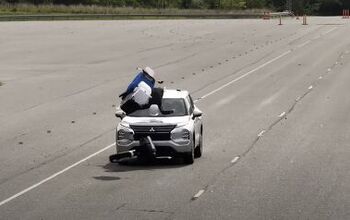The Possibility of a Hotter Honda HR-V Emerges

Suffice it to say no one was talking about Honda’s HR-V subcompact crossover until this news broke. It sells well, quite well, but the little ute — like most subcompact crossovers — may as well be invisible.
What are people suddenly talking about? The emergence of an HR-V Sport on the other side of the Atlantic, boasting a turbocharged 1.5-liter VTEC four-cylinder that’s good for 180 horsepower — just like the one found in the Civic Sport.
That mill generates 177 lb-ft of torque, which, while not as potent as the version found in the Si, is a considerable step up from the UK-market HR-V’s naturally aspirated 1.5-liter base engine, which generates 126 hp and 114 lb-ft of torque. North American HR-Vs benefit from a 1.8 base mill capable of getting the little ute out of its own way. Still, the 1.8L remains the only engine available, providing owners with just 127 lb-ft to go with its 141 ponies, even in the U.S.-market Sport trim.
Besides the new engine, the Brits gain a black mesh grille to replace the horrible, Acura-esque chrome blade that took over the HR-V’s face following a recent refresh, 18-inch wheels, and a tuned suspension to cut down on body roll in corners. The HR-V rolls a lot, if I recall correctly. It’s worth noting that the UK model, due out early next year, comes only in front-wheel drive guise and carries either a six-speed manual or a CVT.
So, that’s great for the long-suffering motorists of the UK, but what about us? We have the car and the engine; what about a pair-up? Thus far, Honda’s staying tight-lipped on the availability of the engine coming to the North American HR-V, though there’s no reason for it not to. “Sport” should mean something.
The HR-V’s competition is heating up considerably. Just this year, we’ve seen the introduction of the Ford EcoSport, Hyundai Kona, and Nissan Kicks in the smallest CUV space. U.S. volume is lower in 2018, too, with sales down by 6.7 percent through the end of October.
It might not be a vehicle you care about, but others might — and light trucks are where Honda’s growth lies. Giving the consumer reason not to choose the Kona turbo (175 hp, 195 lb-ft) would surely work to Honda’s advantage.
[Image: Honda]

More by Steph Willems
Latest Car Reviews
Read moreLatest Product Reviews
Read moreRecent Comments
- Namesakeone If I were the parent of a teenage daughter, I would want her in an H1 Hummer. It would be big enough to protect her in a crash, too big for her to afford the fuel (and thus keep her home), big enough to intimidate her in a parallel-parking situation (and thus keep her home), and the transmission tunnel would prevent backseat sex.If I were the parent of a teenage son, I would want him to have, for his first wheeled transportation...a ride-on lawnmower. For obvious reasons.
- ToolGuy If I were a teen under the tutelage of one of the B&B, I think it would make perfect sense to jump straight into one of those "forever cars"... see then I could drive it forever and not have to worry about ever replacing it. This plan seems flawless, doesn't it?
- Rover Sig A short cab pickup truck, F150 or C/K-1500 or Ram, preferably a 6 cyl. These have no room for more than one or two passengers (USAA stats show biggest factor in teenage accidents is a vehicle full of kids) and no back seat (common sense tells you what back seats are used for). In a full-size pickup truck, the inevitable teenage accident is more survivable. Second choice would be an old full-size car, but these have all but disappeared from the used car lots. The "cute small car" is a death trap.
- W Conrad Sure every technology has some environmental impact, but those stuck in fossil fuel land are just not seeing the future of EV's makes sense. Rather than making EV's even better, these automakers are sticking with what they know. It will mean their end.
- Add Lightness A simple to fix, strong, 3 pedal car that has been tenderized on every corner.


































Comments
Join the conversation
The HRV isn't a bad mini SUV. I test drove a manual LX. It was very slow though and very loud at highway speeds. The 1,5T engine would do wonders, at least to the acceleration.
While we're at it, how about the 2.0 turbo in the CR-V?